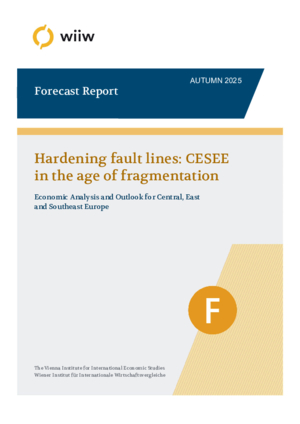Hardening fault lines: CESEE in the age of fragmentation
Vasily Astrov, Alexandra Bykova, Selena Duraković, Meryem Gökten, Richard Grieveson, Maciej Grodzicki, Ioannis Gutzianas, Doris Hanzl-Weiss, Marcus How, Gabor Hunya, Branimir Jovanović, Niko Korpar, Dzmitry Kruk, Sebastian Leitner, Benedetta Locatelli, Isilda Mara, Emilia Penkova-Pearson, Olga Pindyuk, Sara Rehak, Sandor Richter, Marko Sošić, Bernd Christoph Ströhm and Maryna Tverdostup
wiiw Forecast Report No. Autumn 2025, October 2025
146 pages including 30 Tables and 42 Figures
The current report is only available to members. Past issues become freely available online when the next report is released. Several individual sections of the report are freely available to download now (see below).
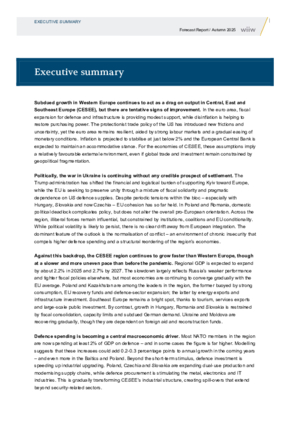
Executive summary
by Richard Grieveson
free download
Indicators 2023-2024 and Outlook 2025-2027
Premium Members only
Summary of key recent macroeconomic data for CESEE, and overview of new wiiw forecasts for 2025-2027 (Excel file)
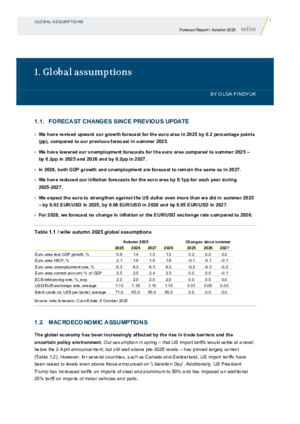
1. Global assumptions
by Olga Pindyuk
The global outlook remains shaped by rising protectionism and geopolitical fragmentation, with the US imposing broad tariffs that disrupt trade and dampen investment confidence. The euro area should see modest growth supported by defence and infrastructure spending, while lower inflation and a stronger euro stabilise conditions but leave Europe exposed to external uncertainty.
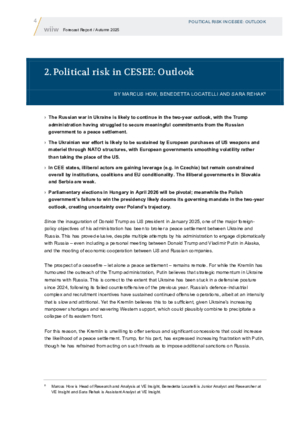
2. Political risk in CESEE: Outlook
by Marcus How, Benedetta Locatelli and Sara Rehak
The war in Ukraine shows no sign of resolution, as the US shifts much of the financial burden of support to Europe and the EU struggles to maintain unity amid rising illiberalism. Across Central and Eastern Europe, political volatility is set to persist, but institutions, coalitions and EU conditionality continue to limit systemic drift from the European mainstream.
free download
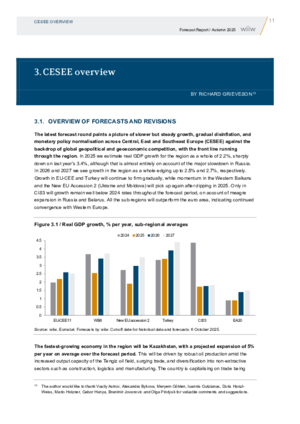
3. CESEE overview
by Richard Grieveson
CESEE will continue to outpace Western Europe in growth, supported by EU funds, rearmament and near-shoring, even as fiscal tightening and weak exports weigh on momentum. The region faces a critical juncture: labour shortages and eroded competitiveness could either constrain growth or force a long-overdue shift toward higher productivity, investment and innovation.
CESEE stands at a crucial turning point, as labour shortages, the inflation shock and geopolitical developments potentially force a shift from a low-wage, export-driven model toward one based on investment, innovation and higher productivity.
Reference to wiiw databases: wiiw Annual Database, wiiw Monthly Database
Keywords: CESEE Central and Eastern Europe, economic forecast, Western Balkans, CIS, Ukraine, Russia, Turkey, EU, business cycle, economic sentiment, euro area, convergence, labour markets, unemployment, Russia-Ukraine war, commodity prices, inflation, price controls, trade disruptions, renewable energy, gas, electricity, monetary policy, fiscal policy
JEL classification: E20, E21, E22, E24, E32, E5, E62, F21, F31, H60, I18, J20, J30, O47, O52, O57, P24, P27, P33, P52
Countries covered: Albania, Austria, Belarus, Bosnia and Herzegovina, Bulgaria, Central and East Europe, CESEE, CIS, Croatia, Czechia, Estonia, Euro Area, European Union, Hungary, Kazakhstan, Kosovo, Latvia, Lithuania, Moldova, Montenegro, North Macedonia, Poland, Romania, Russia, Serbia, Slovakia, Slovenia, Southeast Europe, Turkey, Ukraine, US, Western Balkans
Research Areas: Macroeconomic Analysis and Policy, International Trade, Competitiveness and FDI
ISBN-13: ISBN 978-3-85209-082-5
